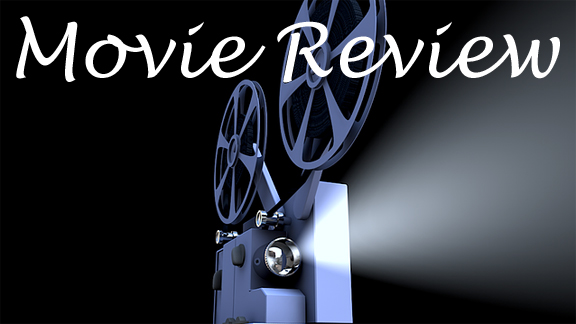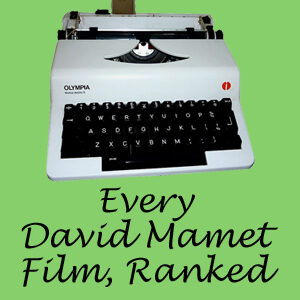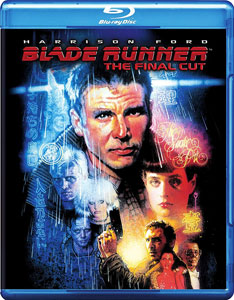“Blade Runner” (1982, with director Ridley Scott’s “Final Cut” following in 2007) serves as a demarcation of child and adult movie tastes. I grew up a “Star Wars” kid, and as a teenager in the 1990s, a friend helped me catch up on other sci-fi classics via VHS rentals of “Alien,” “Terminator” and “Blade Runner.” Hoping on some level for space battles or at least flying-car chases, “Blade Runner” seemed slow and nonsensical to me.
My story probably mimics that of other fans: Watching it today (in the month the fictional events take place!), I absolutely love “Blade Runner.” The artistic design – neon, perpetual night, rain, crumbling buildings, crumbling humanity, the apparent resurrection of Atari and Pan-Am — is such that it should be watched inside a gilded frame rather than a TV set.
(If one wants to be brutally critical, some matte-painting-dependent shots look two-dimensional by today’s standards. But even then, we know what “Blade Runner” is going for and forgive the 1982 technology while also being pleased that the film paves the way for 21st century movies that have the tech to do future-scapes right.)

“Blade Runner” (1982)
Director: Ridley Scott
Writers: Hampton Fancher, David Webb Peoples, Philip K. Dick
Stars: Harrison Ford, Rutger Hauer, Sean Young
Philip K. Dick said the filmmakers captured what he imagined when writing “Do Androids Dream of Electric Sheep?” (1968), and that statement is a wonderful final insight from PKD, who died shortly before the film’s release. His books don’t include a lot of architectural or landscape description (such things are not needed in books, but they are in films), so “Blade Runner” opens up the world of PKD to another medium. (For now, let’s not dwell too much on whether future filmmakers grabbed the baton or fumbled it.)
As for the slowness of “Blade Runner’s” pacing … well, that’s time for letting the themes soak into you even as you enjoy how the film looks. It’s objectively slow but I don’t care that it’s slow. I cared more in the sequel, “Blade Runner 2049,” because it struck me as too deliberate.
Movie versus book
Faithful adaptation in many ways
Written by Hampton Fancher and David Peoples, “Blade Runner” is pretty darn faithful to PKD’s book. It leaves some things out and tightens up the plotting in smart and necessary ways.
In “Androids,” Rick Deckard’s foremost concern is to earn enough money to buy an animal; he has a wife, although both of their moods are dependent on their mood organ more so than mutual marital support. Especially in the movie – where he’s a “blade runner” rather than a “bounty hunter” — killing replicants is an unsavory job to Deckard (Harrison Ford, already a mega-star from “Star Wars” and “Indiana Jones”), and the humanity he sees in his targets clearly bothers him.

Isidore – renamed J.F. Sebastian (William Sanderson) in the movie – is surrounded by kipple (useless ephemera) in the book, but Fancher and Peoples tighten up the plotting so that he’s surrounded by toys that are byproducts of his work for the Tyrell Corporation. (And they are also his friends. So he literally “makes” lots of friends.) The Los Angeles-based company builds replicants to serve as soldiers in space warfare, drawing from artistic/scientific work by people like Sebastian and Chew (James Wong), who specializes in replicants’ eyes.
It is arguably strange that Sebastian and Chew live and work in squalor rather than being based in labs at the grand temple that is the Tyrell building. But I suppose it’s an example of corporate greed, something that’s not a centerpiece of Dick’s book, but not off brand either.
It drops Deckard’s animal obsession
“Blade Runner” completely drops Deckard’s animal obsession (although animals remain a central motif), the mood organ and the Mercerism religion’s empathy box, wherein people share emotions with the collective consciousness. Those are rich elements in “Androids,” but not necessary to the core of the story, and their absence doesn’t hurt the film.
(It does make Deckard’s motivations vaguer, though. His boss gives him a thinly veiled threat along the lines of “If you don’t hunt these replicants for me, you’ll be hunted next.” But then the film pulls back from this, and we get a sense that Deckard is doing what he knows how to do because it’s easier than finding a new line of work.)
The tone is the same in both the book and film: melancholy. Oh so melancholy. But the flavor of the sadness is different. It’s kind of amusing under PKD’s pen, but it’s grand and beautiful under Scott’s direction, the art design and the ubiquitous (but we wouldn’t have it any other way) synthesizer and horn music by Vangelis.
“Blade Runner” includes raw elements we’ve seen in many other movies – for example, Deckard guns down the fugitive Zhora (Joanna Cassidy) after a chase through the streets and later puts the moves on the innocent Rachael (Sean Young). A shootout and a love scene. But instead of the thrill and adrenaline of the hunt, the overwhelming feeling is sadness. Instead of the excitement of starting up a romance, it’s bittersweet at best.
Is Deckard a human who kills replicants? Or is he a replicant who kills ‘humans’?
He hunts killers
The four replicants Deckard hunts down are killers – their slaughter of a spaceship crew is well documented, plus Leon (Brion James) guns down a Tyrell worker and Roy Batty (the late Rutger Hauer) murders Tyrell (Joe Turkell) himself. But they are also slaves, and they are also children. “Blade Runner” walks a tightrope where Deckard is the hero – albeit a noir antihero, doing dirty work no one else will do, and never believing it’s right – and the villains have killed innocents, yet we don’t think of their conflict as good versus evil.
The notion of replicants as tragic figures comes to the fore via Hauer’s masterful turn as Batty, who is alternately scary and childlike, and who actually saves the life of Deckard before dying of “natural” causes; as a replicant, his time simply runs out. When Roy eloquently speaks of the tragedy of the end of a life, it’s totally beside the point whether he’s referring to a replicant or a human. Because his beautiful speech about memories being lost like tears in rain could apply to either “real” or “artificial” beings, it clinches the point of “Blade Runner”: that the distinction is irrelevant.
A less talked-about aspect of Batty’s monolog is the specific memories he pulls: warfare at Tannhauser Gate and involving C-beams. Bred for war, Batty finds beauty in specific snapshots within war. The references also lend beauty to PKD’s space futures and they widen the world of “Blade Runner.”
Earth on its last legs
The saga doesn’t go to space here, but we know it can, and we know it has to, because we see Earth society is on its last legs. The promise of a vaster PKD world pays off in a way in the 1998 film “Soldier,” which is set in the “BR” universe, and in the second PKD adaptation, 1990’s “Total Recall,” which goes to Mars.
A popular conversation topic around “Blade Runner” is the question of whether Deckard himself is a replicant. The conventional sci-fi twist – nicely done in PKD’s short story “Impostor” — would be that he is. Rachael – who in my opinion covers the base of “replicant who thought she was human” — asks Deckard if he’s taken the Voigt-Kampff Test himself, and he doesn’t answer.
Thanks to the sequel, we can definitively say Deckard is human, and I think it’s clear enough in “Blade Runner’s” theatrical release too. When watching either the 1982 or 2007 versions – or the international release (1982) or “The Director’s Cut” (1992) or any of the other slightly different versions — the best answer to “Is Deckard human?” is “It doesn’t matter,” just as it doesn’t matter if Batty is talking about himself or everyone when he’s lamenting lost memories. What does matter is life, and when Batty can’t save his own life, he perhaps derives satisfaction from saving that of his enemy.
Thoughts on the different versions of ‘Blade Runner’
Searching for meaning
But for those who prefer to explore the mystery further, in “The Final Cut” Scott adds a moment of Deckard dreaming about a unicorn. This adds a second meaning to the origami unicorn Gaff (Edward James Olmos) leaves at Deckard’s apartment. The first meaning is that he was there and chose not to kill Rachael, even though it would be good for Gaff’s budding career as a blade runner to do so. (Gaff has become more “human” – by the spiritual definition – as has Batty, and as Deckard will perhaps learn to do.)
The second meaning, in “The Final Cut,” is that Gaff knows that androids dream of unicorns, and by leaving the origami, he is teasing Deckard – telling him he knows Deckard is a replicant.
However, the unicorn connection can also be rationalized as the film teasing the viewer with a coincidence. “The Final Cut” doesn’t definitively state Deckard is a replicant, and therefore if we prefer that the movie line up with Dick’s book on that count, we can say it does.
Another major question that comes up is “What’s the best version of ‘Blade Runner?’ ” In addition to emphasizing the unicorn connection, Scott’s “Final Cut” has two major tonal differences from the theatrical cut.
Tonal differences
First, it excises Deckard’s voiceovers. I have been an apologist for voiceovers on this film and on some other projects; sometimes they nicely evoke 1940s film noir and/or draw a viewer closer to the protagonist. The latter is the case in Season 1 of “Roswell,” for instance. The more I think about it, though, they aren’t needed here. “Blade Runner” has an extremely simple plot, and the motivations of Deckard, Batty and Gaff are more interesting to pore over than to be told outright what they are. And the film is so drenched in film noir stylings that to add a VO is to be too on-the-nose.
Second, “The Final Cut” drops the happy ending coda, wherein Rachael and Deckard drive through the open, virginal countryside (perhaps nature is reclaiming the land after nuclear war, like in PKD’s “The Penultimate Truth”). In the happy ending, Deckard explains in a VO that Rachael – being Tyrell’s newest model – doesn’t have the shortened lifespan like the Nexus-6 models.
Like a human couple, they plan to enjoy the time they have together. Hated by some as an “unearned” ending, it actually flows pretty well from the information we know so far, including Rachael’s stated desire to run away to the north. But if the VOs go, this ending has to also, because it’s only via Deckard’s VO that we know the status of Rachael’s lifespan.
A less talked about – but crucial, in my opinion — change is that Batty calls Tyrell “father” in “The Final Cut,” rather than the theatrical cut’s “f***er.” Both words fall within the unpredictable personality of Batty, but “father” is poetic whereas “f***er” is crude, and we already know Batty has a poetic streak. Also, Batty seeing Tyrell as his father is creepy considering that he’s going to kill Tyrell if he doesn’t get what he wants. And it matches with the rest of the film in terms of Batty’s calm pre-attack behavior and his viciousness when he finally does cut loose.
Aside from the unicorn dream, “The Final Cut” makes the right choices on the major issues, and the unicorn dream is certainly not a deal-breaker for me. But regardless of whether you’re talking about the theatrical release, “The Final Cut,” the international cut, “The Director’s Cut” or another version, one thing remains the same: The first PKD movie is still the best.

